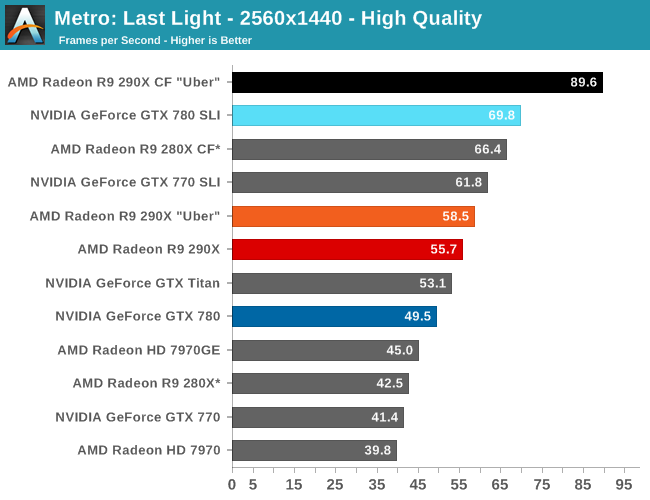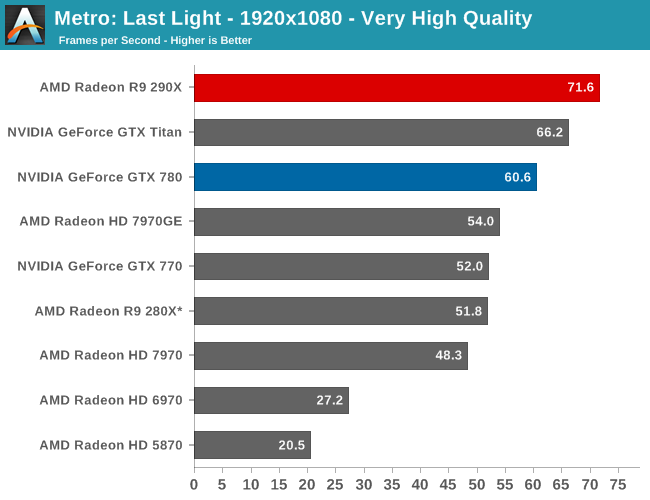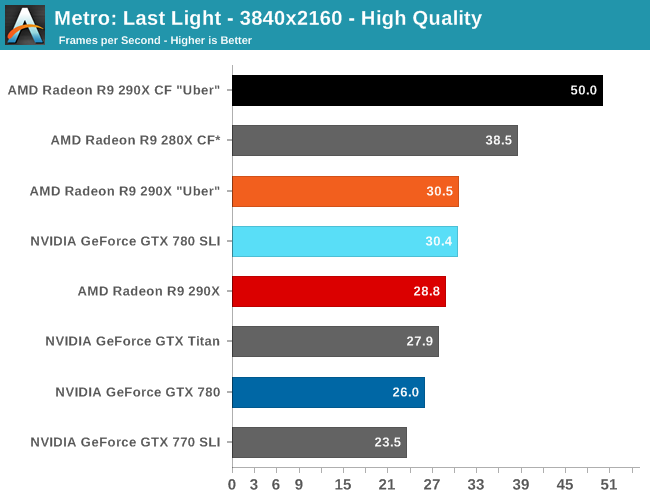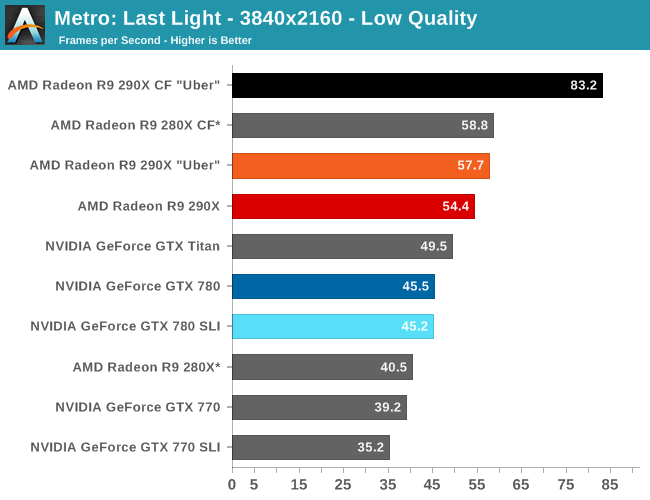The AMD Radeon R9 290X Review
by Ryan Smith on October 24, 2013 12:01 AM EST- Posted in
- GPUs
- AMD
- Radeon
- Hawaii
- Radeon 200
Metro: Last Light
As always, kicking off our look at performance is 4A Games’ latest entry in their Metro series of subterranean shooters, Metro: Last Light. The original Metro: 2033 was a graphically punishing game for its time and Metro: Last Light is in its own right too. On the other hand it scales well with resolution and quality settings, so it’s still playable on lower end hardware.


For the bulk of our analysis we’re going to be focusing on our 2560x1440 results, as monitors at this resolution will be what we expect the 290X to be primarily used with. A single 290X may have the horsepower to drive 4K in at least some situations, but given the current costs of 4K monitors that’s going to be a much different usage scenario.
With that said, for focusing on 4K on most games we’ve thrown in results both at a high quality setting, and a lower quality setting that makes it practical to run at 4K off of a single card. Given current monitor prices it won’t make a ton of sense to try to go with reduced quality settings just to save $550 – and consequently we may not keep the lower quality benchmarks around for future articles – but for the purposes of looking at a new GPU it’s useful to be able to look at single-GPU performance at framerates that are actually playable.
With that said, starting off with Metro at 2560 the 290X hits the ground running on our first benchmark. At 55fps it’s just a bit shy of hitting that 60fps average we love to cling to, but among all of our single-GPU cards it is the fastest, beating even the traditional powerhouse that is GTX Titan. Consequently the performance difference between 290X and GTX 780 (290X’s real competition) is even greater, with the 290X outpacing the GTX 780 by 13%, all the while being $100 cheaper. As we’ll see these results are a bit better than the overall average, but all told we’re not too far off. For as fast as GTX 780 is, 290X is going to be appreciably (if not significantly) faster.
290X also does well for itself compared to the Tahiti based 280X. At 2560 the 290X’s performance advantage stands at 31%, which as we alluded to earlier is greater than the increase in die size, offering solid proof that AMD has improved their performance per mm2 of silicon despite the fact that they’re still on the same 28nm manufacturing process. That 31% does come at a price increase of 83% however, which although normal for this price segment serves as a reminder that the performance increases offered by the fastest video cards with the biggest GPUs do not come cheaply.
Meanwhile for one final AMD comparison, let’s quickly look at the 290X in uber mode. As the 290X is unable to sustain the power/heat workload of a 1000MHz Hawaii GPU for an extended period of time, at its stock (quiet settings) it has to pull back on performance in order to meet reasonable operational parameters. Uber mode on the other hand represents what 290X and the Hawaii can do when fully unleashed; the noise costs won’t be pretty (as we’ll see), but in the process it builds on 290X’s existing leads and increases them by another 5%. And that’s really going to be one of the central narratives for 290X once semi-custom and fully-custom cards come online: Despite being a fully enabled part, 290X does not give us everything Hawaii is truly capable of.


Moving on, let’s talk about multi-GPU setups and 4K. Metro is a solid reminder that not every game scales similarly across different GPUs, and for that matter that not every game is going to significantly benefit from multi-GPU setups. Metro for its part isn’t particularly hospitable to multi-GPU cards, with the best setup scaling by only 53% at 2560. This is better than some games that won’t scale at all, but it won’t be as good as those games that see a near-100% performance improvement. Which consequently is also why we dropped Metro as a power benchmark, as this level of scaling is a poor showcase for the power/temp/noise characteristics of a pair of video cards under full load.
The real story here of course is that it’s another strong showing for AMD at both 2560 and 4K. At 2560 the 290X CF sees better performance scaling than the GTX 780 SLI – 53% versus 41% – further extending the 290X’s lead. Bumping the resolution up to 4K makes things even more lopsided in AMD’s favor, as at this point the NVIDIA cards essentially fail to scale (picking up just 17%) while the 290X sees an even greater scaling factor of 63%. As such for those few who can afford to seriously chase 4K gaming, the 290X is the only viable option in this scenario. And at 50fps average for 4K at high quality, 4K gaming at reasonable (though not maximum) quality settings is in fact attainable when it comes to Metro.
Meanwhile for single-GPU configurations at 4K, 4K is viable, but only at Metro’s lowest quality levels. This will be the first of many games where such a thing is possible, and the first of many games where going up to 4K in this manner further improves on AMD’s lead at 4K. Again, we’re not of the opinion that 4K at these low quality settings is a good way to play games, but it does provide some insight and validationg into AMD’s claims that their hardware is better suited for 4K gaming.










396 Comments
View All Comments
46andtool - Thursday, October 24, 2013 - link
I dont know where your getting your information but your obviously nvidia biased because its all wrong. AMD is known for using poor reference coolers, once manufactures like sapphire and HIS roll out there cards in a couple weeks Im sure the noise and heat wont be a problem. and the 780ti is poised to be between a 780gtx and a titan, it will not be faster than a 290x, sorry. We already have the 780ti's specs..what Nvidia needs to focus on is dropping its insane pricing.SolMiester - Monday, October 28, 2013 - link
Sorry bud, but the Ti will be much faster than Titan, otherwise there is no point, hell even the 780OC is enough to edge the Titan. Why are people going on about Titan, its a once in a blue moon product to fill a void that AMD left open with CUDA dev for prosumers...Full monty with perhaps 7ghz memory, wahey!Samus - Friday, October 25, 2013 - link
What in the world makes you think the 780Ti will be faster than Titan? That's ridiculous. What's next, a statement that the 760Ti will be faster than the 770?TheJian - Friday, October 25, 2013 - link
http://www.techradar.com/us/news/computing-compone...Another shader and more mhz.
http://news.softpedia.com/news/NVIDIA-GeForce-GTX-...
If the specs are true quite a few sites think it will be faster than titan.
http://hexus.net/tech/news/graphics/61445-nvidia-g...
Check the table. 780TI would win in gflops if leak is true. The extra 80mhz+1SMX mean it should either tie or barely beat it in nearly everything.
Even a tie at $650 would be quite awesome at less watts/heat/noise possibly. Of course it will be beat a week later buy a fully unlocked titan ultra or more mhz, or mhz+fully unlocked. NV won't just drop titan. They will make a better one easily. It's not like NV just sat on their butts for the last 8 months. It's comic anyone thinks AMD has won. OK, for a few weeks tops (and not really even now other than price looking at 1080p and the games I mentioned previously).
ShieTar - Thursday, October 24, 2013 - link
It doesn't cost less than a GTX780, it only has a lower MSRP. The actual price for which you can buy a GTX780 is already below 549$ today, so as usual you pay the same price for the same performance with both companies.And testing 4K gaming is important right now, but it should be another 3-5 years before 4K performance actually impacts sales figures in any relevant way.
And about Titan? Keep in mind that it is 8 months old, still has one SMX disabled (unlike the Quadro K6000), and still uses less power in games than the 290X. So I wouldn't be surprised to see a Titan+ come out soon, with 15 SMX and higher base clocks, and as Ryan puts it in this article "building a refined GPU against a much more mature 28nm process". That should be enough to gain 10%-15% performance in anything restricted by computing power, thus showing a much more clear lead over the 290X.
The only games that the 290X will clearly win are those that are restricted by memory bandwidth. But nVidia have proven with the 770 that they can operate memory at 7GHz as well, so they can increase Titans bandwidth by 16% through clocks alone.
Don't get me wrong, the 290X looks like a very nice card, with a very good price to it. I just don't think nVidia has any reason to worry, this is just competition as usual, AMD have made their move, nVidia will follow.
Drumsticks - Thursday, October 24, 2013 - link
http://www.newegg.com/Product/ProductList.aspx?Sub...Searched on Newegg, sorted by lowest price, lowest one was surprise! $650. I don't think Newegg is over $100 off in their pricing with competitors.
46andtool - Thursday, October 24, 2013 - link
http://www.newegg.com/Product/Product.aspx?Item=N8...your clearly horrible at searching
TheJian - Friday, October 25, 2013 - link
$580 isn't $550 though right? And out of stock. I wonder how many of these they can actually make seeing how hot it is already in every review pegged 94c. Nobody was able to OC it past 1125. They're clearly pushing this thing a lot already.ShieTar - Friday, October 25, 2013 - link
Well, color me surprised. I admittedly didn't check the US market, because for more than a decade now, electronics used to be sold in the Euro-Region with a price conversion assumption of 1€=1$, so everything was about 35% more expensive over here (but including 19% VAT of course).So for this discussion I used our German comparison engines. Both the GTX780 and the R290X are sold for the same price of just over 500€ over here, which is basically 560$+19%VAT. I figured the same price policies would apply in the US, it basically always does.
Well, as international shipping is rarely more that 15$, it would seem like your cheapest way to get a 780 right now is to actually import it from Germany. Its always been the other way around with electronics, interesting to see it the other way around for once.
46andtool - Thursday, October 24, 2013 - link
the price of a 780gtx is not below $649 unless you are talking about a refurbished or open box card.